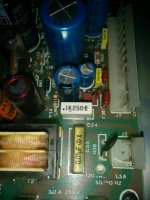"Yes, definitely replace C33 at the same time as C32. There may be a third replace-immediately cap in there, too. I recall that there is one hiding in another corner on some of the Astec supplies in the Model 12 and Model 6000, but I don't remember if the 4P supply also has a third cap, and I don't think I've examined any non-Astec Tandy supplies yet. I recommend always replacing those yellow Rifa paper dielectric safety-rated caps on sight before applying power."
I did go over the Tandy power supply once or twice in good light. The larger electrolytics all appear clean with no swelling. I might ESR some of them Friday when the replacements for the RIFA's arrive just to make sure. I got distracted the other day googling about the RIFA capacitors. It seems the audio philes have had the same issues with RIFA's going solar sometimes even in a device that was not even turned on.
"Most of the Astec supplies I've encountered in TRS-80 computers already had 3-4 holes for each of those yellow incendiary capacitors to support different lead spacings. But even if the caps you can find don't have exactly the same spacings as any of the hole pairs, close enough is good enough if you buy caps with long enough leads. Just avoid caps with very short leads that thus need to be mounted right against the PCB with holes at the precise spacing of the leads. I picked out Panasonic safety-rated film caps that had nice long leads, allowing them to be installed in spots where the holes weren't at the matching spacing."
Ugh, I should have waited for the email. One of my concerns was ordering something electrically similar but physically a different size. Even with the long leads I would like to keep it as close in to the board as possible and this was one of my concerns. I haven't removed the old caps and will do that when the new ones come in on Friday. The ones I wound up ordering I think are similar (or identical to your Panasonic's) from Digikey
C32 .22μf
http://www.digikey.com/scripts/DkSearch/dksus.dll?Detail&itemSeq=200030183&uq=636020474327819893
C33 10000PF
http://www.digikey.com/scripts/DkSearch/dksus.dll?Detail&itemSeq=200030190&uq=636020474327819893
I think I found that third capacitor. I didn't give it a second look earlier as it didn't have the traditional cracked plastic RIFA case. It is C24 in my Tandy supply .1K 250. Do they use Nano farads on these...? .1K nF would match the third capacitor from your comment. I think I am going to have to just order it and let it sit in the in box until I need other stuff as well since I need to pay $7 or so for shipping each time from Digi-Key or Mouser.
BTW, are the newer KEMET equivalents of the RIFA's any good or is it just a good best practice to avoid the metallized paper and replace with metallized polypropylene?

Thanks!



